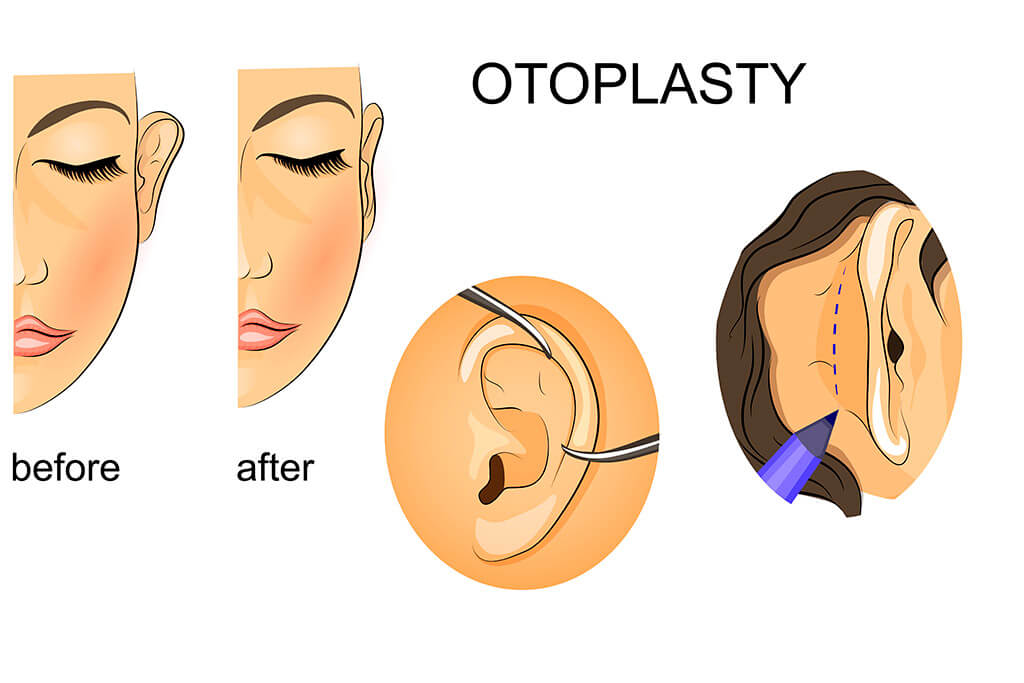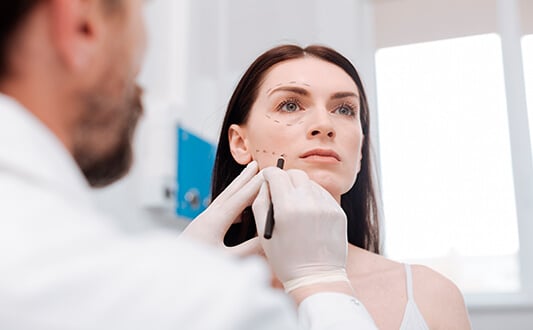Otoplasty is defined as a surgical intervention aimed at the correction of auricles’ form or location. Surgery can be either aesthetic or reconstructive. Aesthetic surgeries are mainly performed due to cosmetic indications to improve one’s appearance. Reconstructive otoplasty is carried out in cases of an ear injury or congenital defects of its development.
Content
- Who Needs to Undergo Otoplasty?
- Reconstruction of the Auricle for Congenital Pathologies
- Post-operative Complications
- Laser Otoplasty
- What is the Price of Otoplasty?
- Where is it Possible to Undergo Otoplasty?
- How to Undergo Otoplasty in Germany?
Who Needs to Undergo Otoplasty?
Most frequently, kids born with protruding ears are among those who need to undergo otoplasty. The ideal time to undergo this procedure is between the ages of 6-8 years old (depending on the speed of the child’s physical development). Sometimes, people correct protruding ears once they become adults.
These are some other indications to perform surgery:
- congenital defects of the ear development (absence of an ear, its underdevelopment, or irregular shape);
- acquired defects (consequences of a trauma, surgery, purulent inflammatory processes, oncologic diseases, etc.);
- aesthetic needs of a person (at his/her request, an operation to reduce the size of the ears, ear lobes, etc. ear plastic surgery can be conducted).
Reconstruction of the Auricle for Congenital Pathologies
Deformation of an auricle is divided into two big groups. These can be both congenital and acquired. Reconstructive otoplasty is frequently required to fix defects like this.
Types of congenital ear defects
Varieties of congenital deformities:
- anotia - absence of ears;
- microtia - underdevelopment of ears (happens with or without obliteration of an auditory pass);
- hypoplasia (underdevelopment) of an auricle’s middle part;
- hypoplasia of the upper part;
- Protruding ears.
Hypoplasia of the upper part of the auricle is divided into the following types:
- "hidden ear" - the rim of the cartilage curl is located under the scalp skin;
- folded ears;
- hypoplasia of the entire upper ear.
In practice, otoplasty is most often carried out for protruding ears correction. Other defects are much less common.
At what age is the surgery performed?
The best age to perform otoplasty is defined by both a surgeon and otolaryngologist. The participation of the latter is necessary as congenital ear defects are often accompanied by hearing problems.
The main factors that prompt professionals to choose the most ideal time for otoplasty procedure are:
- The degree of costal cartilage maturity, which can be used as a source of cartilaginous tissue to replace defects in the auricles.
- The general health of the child (sometimes deformities of the ear are combined with other developmental defects, including anomalies in the development of the spine, organs of the urinary system, etc.).
- Correspondence of the size of the costal cartilage to the size of the normal ear.
- Psychological factor - the child could be ostracized as a result of this ear deformity, so the ear correction is carried out as early as possible
According to estimates by child psychologists who have observed patients with microtia, there is a distinct difference in appearance from other children when they are aged 3-4 years. However, they only experience an expressed psychological discomfort from the age of 6-7 years, when they first go to school. Therefore, the best time for otoplasty in children is at the age of 6 years old. The costal cartilage may not be large enough at an earlier age to form a skeleton of the auricle. In addition, by this time, the structure and shape of the normal ear is usually fully formed.
Auricle reconstruction for the correction of microtia
A full reconstruction of the auricle is performed for the treatment of microtia. Reconstruction of the outer ear is conducted from the costal cartilage. It is taken from the side opposite to the location of the ear requiring reconstruction. In cases of a bilateral microtia ear correction surgery, two stages are carried out. First, one ear is corrected, and then the other one is corrected after six weeks. This is due to the need for healing the donor sites.
A child remains in the hospital after otoplasty. Every few hours, the drainage tanks are changed. The drainage itself (tubes through which the liquid is drained from the operation zone) is usually removed after 5 days. Until then, the child receives antibiotics to prevent infectious complications.
Pain in the area of the patient’s reconstructed ears doesn’t bother him/her. There may be pain in the chest area, where the costal cartilage was taken from. The administration of analgesics for pain relief is prescribed in such cases. Breathing exercises are used to prevent pulmonary complications.
Features of further rehabilitation after otoplasty are:
- the stitches are removed after 1 week;
- the bandages are removed after 12 days;
- a child can go to school in 2 weeks;
- an adult can take part in sports in 4 weeks;
- adolescents and children can exercise a little later - 6 weeks after the otoplasty.
It is forbidden to sleep on the operated-on side. The patient cannot use a hairdryer for 2 months. Afterwards, the following stages of otoplasty are performed. One, two, or sometimes three surgeries may be required to correct the defect.
The surgeries are held with 2 month intervals between them:
- Earlobes plastics - the purpose of this operation is to shift the earlobe upward after an intervention positioned it in an anatomically correct horizontal position.
- Lifting of the auricle - it is separated from the tissues of the head.
- Formation of a tragus (cartilaginous lobe located at the base of the shell) and providing a symmetrical structure of the ear.
Otoplasty for microtia treatment is a two-stage procedure that is performed at modern German hospitals. Thus, a child will tolerate the surgery better. An operation reduces the suffering for children and has a much lower risk of complications. The price of otoplasty in Germany is higher, though the surgeries are safer and ensure a better aesthetic effect.
Otoplasty for folded auricle treatment
A folded auricle is a congenital defect, when the upper part is bent forward and down. This pathology has three stages of severity:
- Stage 1 – the ear can be bent and then it looks normal
- Stage 2 – it’s impossible to bend the ear because of a lack of tissue
- Stage 3 – all auricle territory is moved forward and the defect is often accompanied with atresia (obliteration) of the auditory bypass and deafness
Otoplasty can be performed in different ways depending on the degree of severity, as well as on the individual features of the auricle’s structure.
It is necessary to surgically mobilize the curl and fix it in an anatomically correct position in order to treat stage 1 of this folded ear disease.
Otoplasty for the treatment of stage 2 is more complicated, as the upper ear has to be restored from deformed cartilage. A doctor will have to move the skin flaps to ensure a good aesthetic effect.
Folded ear at stage 3 requires the reconstruction of the upper ear with the use of a transplant. Cartilage will be taken from another ear. A cartilaginous framework may be formed from the costal cartilage for the treatment of severe cases, as in microtia.
Otoplasty for treatment of congenital defects
A large number of children suffer from birth defects that affect the structure of the ears. Most of them are very rare and not all deformations require reconstructive operations. However, many of them require aesthetic interventions.
We will list the main congenital defects in brief:
- “Satyr ear” means that an ear has a pointed shape. The auricle is stretched upwards. The elimination of this deformation is carried out by an excision of the deformed fragment. Then, the doctor constructs a curl in the correct anatomical shape.
- “Macacus ear” is another name for an angular ear. This defect is characterized by the deformation and thickening of the curl’s descending section. It looks direct and unfolded from the outside. Otoplasty ensures a surgical correction by reconstructing the thickened section of the curl.
- Auricular tubercle (Darwin's tubercle) represents the thickening of the curl’s descending part’s initial edge. Depending on the degree of expression, it can be considered the norm (a feature of the structure of the ear) or a pathology. Operative treatment is carried out with an aesthetic purpose. An excision of excess cartilage and skin of the curl is performed.
- Flat auricle. There is no relief of the auricle. The descending and horizontal part of the curl looks deployed. In these cases, otoplasty is required. Otoplasty offers a form of relief with the help of incisions and tightening sutures.
- Wildermuth’s ear. A too large or prominent antihelix is formed in this defect, protruding above the surface of the curl. Surgical correction consists of an excision of the cartilage and suturing, which presses the cartilage to the mastoid process (bone).
- Stahl’s ear is peculiar, with an additional antihelix leg or pointed appearance. Otoplasty is performed with an excision of the deformed area. Also, several effective methods have been developed to form the correct contours of the auricle. Reconstruction using cartilage transplantation may be required.
- An Ingrown auricle is rarely found among Europeans, though it is common in Asians (one in every 400 children is born with such a structural ear defect). The imposition of modeling dressings is prescribed at a young age. In the future, otoplasty is required. Otoplasty involves the dissection of the altered muscles and the formation of a bovine furrow, to give a more natural look.
Otoplasty for everted (protruding) ears treatment
Protruding (everted) ears are a congenital defect of auricles. Otoplasty is conducted to eliminate this defect due to aesthetic indications. There are a large number of techniques for the correction of protruding ears.
They can be divided into the following three groups:
- The height of the auricle’s bowl decreases - fragments of the cartilage are excised for this, or it is fixed to the mastoid process
- A fold of the antihelix is formed - permanent tightening seams are applied from the inside of the ear cartilage to treat the case
- Formation of the correct anatomical shape of the antihelix - incisions are placed on its outer surface for this purpose
Methods can also be combined. The choice of the best otoplasty for protruding ear correction is determined individually, taking into account the individual features of the structure of the ear and a variety of defects. These are distinguished between:
- protruding ears with a formed antihelix and a detached bowl;
- protruding ears with an underdeveloped antihelix.
The second type of defect is harder to fix. The choice of otoplasty depends on the patient’s age as well. Ear cartilage in children differs; otoplasty is less traumatic with thin cartilage, as opposed to thick cartilage. Adult patients may require an artificial cartilage thinner to make it more flexible.
Before performing an otoplasty, a number of studies are carried out. The patient undergoes tests to determine certain infections. The functions of internal organs are evaluated using general clinical tests. A coagulogram is passed for the assessment of the blood coagulation function. Timely detection of contraindications to otoplasty is vital to avoid complications.
The bandage is applied the day after the surgery. The blood-soaked turunda is removed. A new one is lubricated with antibiotic ointments for the prevention of infections. The second bandage and examination is carried out in a week. It is usually not necessary to remove the stitches - doctors try to use self-absorbing threads nowadays. A special bandage is recommended for sleeping after the correction of protruding ears.The final results of the operation can be seen after 2 months, when the edema completely disappears.
Post-operative Complications
Otoplasty can be followed by complications, as with any other surgery. There are many complications that can arise as a result of a surgeon’s mistake.
The main kinds of complications are:
Post-operative pain, usually evidenced by the presence of a hematoma. Pain lasting up to several days after protruding ears correction, can be a symptom of an inflammatory process. Pain is often less associated with the regeneration of the dissected nerve branches during the intervention.
Infectious complications are very dangerous, because they can endanger the results of the otoplasty for the protruding ears treatment. In adverse cases, perichondritis and necrosis of cartilage are provoked. Suspicion of an inflammatory process requires antibiotic therapy and observation in a hospital.
Cicatricial complications can result in developing keloid or hypertrophic scars at the site of the incision. To eliminate this complication, a conservative therapy, surgical intervention, is used, and sometimes it is necessary to resort to radiation exposure.
Complications can also develop if the technique of the surgery is disturbed. Among these are the following:
- cutting of surgical sutures;
- skin detachment from the cartilage surface;
- impaired blood supply to tissues and an increased risk of inflammatory processes in this area;
- formation of sharp edges of the cartilage;
- formation of unnatural skin folds;
- narrowing of the external auditory canal.
Similar consequences develop because of lowly qualified surgeons. To avoid them, it is better to undergo otoplasty in Germany. The price of treatment will be higher. But, for most parents, it does not matter how much otoplasty is going to cost if it’s for a child. The main thing is that it is going to be successful. In addition, when undergoing otoplasty in an understaffed or poorly equipped clinic, it is not always possible to save money. There may be a need to redo the otoplasty. The price in this case will double, because the second surgical intervention will also have to be paid for in full.
Laser Otoplasty
Laser otoplasty has become more and more popular in recent years. It is aimed at eliminating protruding ears. A laser is used instead of a scalpel, to perform all the necessary manipulations.
Benefits of such an approach are:
- the laser makes a thinner and even cut, which contributes to the rapid regeneration of tissues;
- there is no bleeding, because at the same time, the vessels are coagulated;
- laser otoplasty rarely leads to infectious complications, because the laser destroys bacteria in the wound;
- there is less risk of damage to blood vessels, nerves, and other tissues;
- laser otoplasty is done in just 30-60 minutes and usually does not require general anesthesia;
- minimal risk of visible scars.
Therefore, in view of its benefits, laser otoplasty is gradually taking over traditional scalpel surgery. However, its possibilities are limited, in some clinical situations it cannot be used. The price of laser otoplasty is often higher when compared to a normal operation.
What is the Price of Otoplasty?
Patients who have decided on otoplasty are always interested in how much the correction of ears costs. There is no single, fixed price. Otoplasty is carried out in different ways. Each case of deformation of the auricles or protruding ears is treated accordingly. Therefore, the price of otoplasty is significantly different.
In addition, the cost of otoplasty depends on:
- the authority of the clinic and plastic surgeon;
- operational techniques;
- the country, and even the city where you will undergo such surgery.
If reconstructive otoplasty on the ears is required, the price is usually higher. In addition to that, you sometimes have to undergo surgery in several stages. That is, several operations are performed alternately. The price of otoplasty will depend on the number of surgeries.
Where is it Possible to Undergo Otoplasty?
It is best to have surgery in Germany, if the otoplasty cost doesn’t stop you. The cost of otoplasty in this country is higher compared to developing countries of the CIS, Africa, and Asia. But, the quality of medical services is immeasurably better.
The main advantages of plastic surgery in Germany are:
- Qualitative results of treatment. The latest surgical interventions are used in Germany. In each case, the type of operation is selected individually, based on the specific defect in the structure of the auricle. Complex reconstructive operations are carried out as well. A good aesthetic effect is provided in all cases.
- Interdisciplinary interaction. Doctors of different specialties participate in the surgical reconstruction of the normal shape of the ear structure. These include otolaryngologists, plastic surgeons, and maxillofacial surgeons. Their interaction guarantees not only a qualitative reconstruction of the auricle, but also the restoration of hearing, in case of its dysfunction.
- Treatment of rare deformities. Many congenital defects in the structure of the auricles are rare. Therefore, many surgeons do not have enough experience in correcting the shape of the ears in such cases. But in Germany, patients from all over the world are treated here, therefore German doctors face all kinds of pathologies and successfully operate on them.
- Good tolerability of procedures. Clinics in Germany use modern, safe, and the most effective methods of anesthesia. Children are operated on only under general anesthesia, to avoid emotional trauma.
- High level of comfort. Well-equipped wards, friendly medical staff, and nutritional food and care are waiting for you.
In Germany, you will be given a better chance of a successful surgery. There are more qualified doctors and all the necessary equipment. The clinics are well equipped with the best resources, due to generous state funding for healthcare.
There are only two reasons why some people do not go to Germany to receive corrective surgery of the auricles: the price and the organizational issues. However, the price of otoplasty in say, Moscow for example, is not that much lower than otoplasty in Germany. As for the organizational issues, the Booking Health company can fully assist you with all concerns.
How to Undergo Otoplasty in Germany?
Patients give up on going to Germany, just because they don’t have any idea how to arrange this trip. Indeed, for most people, this task is quite a challenge, but it’s not impossible. You need to find a suitable clinic, contact and negotiate everything with its management, issue the necessary documents, translate them into German, as well as the medical documentation. You need to get to the right city, to the right hospital in Germany, book a hotel, and find an interpreter to communicate with the medical staff.
All of these concerns can be undertaken by the company, Booking Health. Our advantages are:
- Complete arrangement of the trip for treatment, starting with the selection of the hospital and the doctor, followed by the delivery of the patient from the airport to the hospital and back.
- We will support and accompany you during the whole period of your stay in Germany.
- Saving on medical services. Thanks to Booking Health, the cost of otoplasty will be much lower. Besides, you will save on the services that German hospitals offer individuals at a much higher price.
- Good and inexpensive insurance, which will cover all costs in case of complications during treatment and for 4 years upon your completion of treatment.
- Any arrangements with the clinic administration. We will consult with the administration of the hospital to reduce the waiting time for an appointment, organize the staying conditions of your accompanying person, organize individual meals, and resolve any other issues.
To take advantage of cooperation with Booking Health, please leave a request on our website. We will contact you as soon as possible.
Choose treatment abroad and you will for sure get the best results!
Authors:
The article was edited by medical experts, board certified doctors Dr. Nadezhda Ivanisova, Dr. Sergey Pashchenko. For the treatment of the conditions referred to in the article, you must consult a doctor; the information in the article is not intended for self-medication!
Sources:
Read:
Why Booking Health - questions and answers
How to make right decision when choosing the clinic and specialist
7 reasons to trust to the rating of clinics on the Booking Health portal
Don't know where to start?
Contact Booking Health








